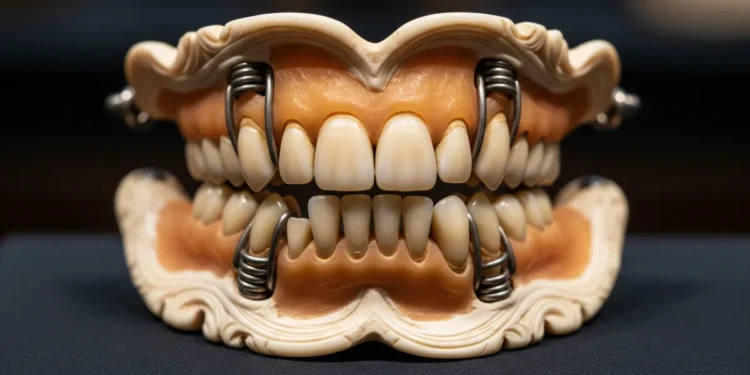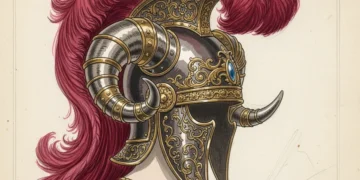Investigates the Washington wooden teeth myth, showing the real materials used (hippopotamus ivory, walrus, human teeth, metal springs), and how the “wood” claim became folklore.
Table of Contents
Introduction
The Washington Wooden Teeth Myth is one of the most durable and misleading fables in American history. It is a story told to schoolchildren, repeated in popular culture, and accepted by millions as an unshakeable fact. Yet, it is entirely false. George Washington never had wooden teeth. This simple fact raises a more profound question: why has such a baseless story not only survived but thrived for centuries? The answer lies in our preference for comforting folklore over complex and often uncomfortable historical truth. This article will dismantle this persistent myth, piece by piece, using the very artifacts it misrepresents.
The reality behind the famous presidential smile is not a tale of rustic simplicity, but one of chronic pain, technological innovation, and the dark, hidden economies of the 18th century. The story of Washington’s dental struggles is a gripping narrative of a man desperate for relief, commissioning sophisticated prosthetics made from hippopotamus ivory, gold wire, and, most disturbingly, teeth purchased from other humans. The consequences of the Washington Wooden Teeth Myth are that it papers over this grim and fascinating reality, replacing a story of human suffering and scientific ambition with a hollow, patriotic fable.
In the following sections, we will first explore the enduring power of the myth itself and detail the agonizing reality of Washington’s lifelong dental problems. We will then act as historical detectives, examining the surviving dentures to reveal what they are truly made of. From there, we will trace how the “wooden” misconception became folklore and place Washington’s prosthetics in the wider context of 18th-century dentistry. Finally, we will argue why dismantling the Washington Wooden Teeth Myth is not just a matter of correcting a minor error, but a crucial act of valuing real, evidence-based history over sanitizing fiction.
The Enduring Power of the Washington Wooden Teeth Myth
From elementary school classrooms to popular trivia nights, the story of George Washington’s wooden teeth is a piece of American folklore treated as fact. This narrative is deeply embedded in the national consciousness, a seemingly harmless detail that has been repeated for generations without question. The Washington Wooden Teeth Myth persists not because of evidence, but because of its cultural resonance. It has become a staple of historical anecdotes, a quick and memorable “fact” that feels both plausible and fitting for a figure from a pre-industrial age. This widespread acceptance makes challenging the myth a necessary first step in understanding the man behind the monument.
The myth’s appeal lies in its alignment with the carefully constructed persona of Washington himself: the humble, rustic leader. It complements the cherry tree tale, another famous fiction designed to illustrate his unimpeachable honesty. In this light, wooden teeth symbolize a rejection of European aristocratic excess, portraying the president as a man of simple, American-made solutions. This narrative is compelling, and it’s why the Washington Wooden Teeth Myth has survived for so long. It reinforces a romanticized vision of the nation’s founding—one that prioritizes moral fables over the more complex, and often uncomfortable, historical realities. The story feels true, even if it isn’t.
While the folklore is powerful, clinging to it obscures a far more fascinating and historically significant truth. The reality of Washington’s dental struggles reveals a story of chronic pain, cutting-edge 18th-century technology, and the brutal, hidden economies that supplied the materials for his sophisticated prosthetics. By deconstructing the flawed Washington Wooden Teeth Myth, we move beyond simple hagiography. We uncover a more human portrait of a founding father and gain a clearer understanding of the material culture and scientific advancements of his time. This article will dismantle the myth to reveal the compelling, and sometimes gruesome, reality behind the famous smile.
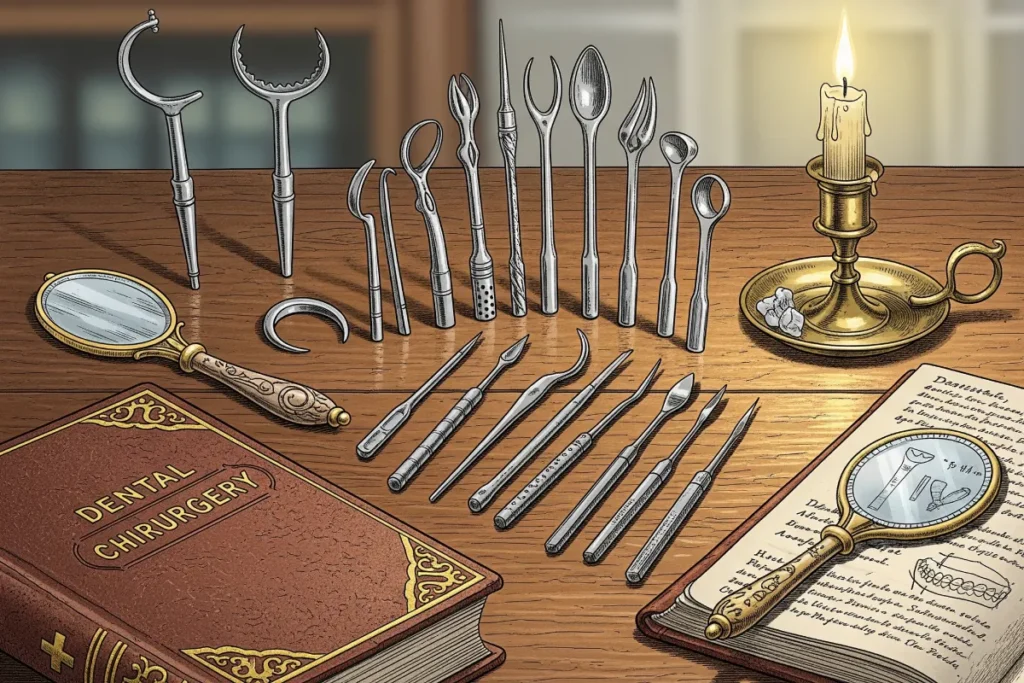
A President’s Pain: Washington’s Lifelong Dental Struggles
Long before the Washington Wooden Teeth Myth took hold, the reality of George Washington’s life was one of near-constant dental agony. His troubles began not in old age but as a young man; records show he had his first tooth pulled at the age of 22. From that point on, his dental health deteriorated rapidly. He suffered from frequent toothaches, inflamed gums, and abscesses, leading to a cascade of extractions throughout his adult life. By the time he was sworn in as the first President of the United States in 1789, he had only a single natural tooth remaining in his mouth. This lifelong struggle necessitated a constant search for functional prosthetic solutions.
The consequences of this poor dental health were profound, impacting both his private comfort and his public persona. His letters and diaries are filled with complaints of pain from his ill-fitting dentures, which were often bulky and uncomfortable. These devices distorted the shape of his mouth and jaw, leading to the sunken, tight-lipped expression familiar from his later portraits. The physical discomfort also made public speaking a challenge, likely contributing to his reputation as a reserved and solemn leader. The reality is that a man leading a new nation was simultaneously fighting a private, debilitating battle against his own body.
Washington’s suffering must be understood within the context of 18th-century dentistry, a field still in its infancy. There were no professional dentists in the modern sense; dental procedures were typically performed by surgeons, ivory turners, or even blacksmiths. Extractions were crude, and prosthetics were experimental and custom-made with whatever materials were available. The lack of understanding about bacteria, infection, and proper fit meant that any solution was temporary and often painful. This backdrop of primitive dental care is essential for rethinking the Washington Wooden Teeth Myth, as it explains why he sought out the most advanced and expensive, non-wooden materials of his era.
Rethinking the Washington Wooden Teeth Myth: The Artifacts Speak
The most compelling rebuttal to the Washington Wooden Teeth Myth comes not from written accounts but from the physical artifacts themselves. Several of George Washington’s dentures survive today, with the most famous and complete set housed at his Mount Vernon estate. These objects offer undeniable, tangible proof that his prosthetics were not carved from wood. When we set aside folklore and engage in a material culture analysis of the dentures, the story shifts from rustic simplicity to one of sophisticated, expensive, and sometimes gruesome craftsmanship. The artifacts are the primary sources, and they tell a story that is far more complex and interesting than the myth they debunk.
Forensic and curatorial examination of these surviving dentures reveals a combination of materials that represented the cutting edge of 18th-century dental technology. The base plates, carved to fit Washington’s gums, were not made of wood but of hippopotamus and walrus ivory. These dense, durable materials could be shaped and polished to a convincing degree. To hold the upper and lower plates together, they were hinged with gold wire springs and fastened with brass screws and even lead. This intricate construction highlights that Washington’s dentures were complex mechanical devices, far from the simple, whittled objects the myth suggests.
The most startling component of Washington’s dentures, however, was the use of real human teeth. To create a natural-looking smile, his dentists purchased teeth and riveted them into the ivory base. Washington’s accounting records show payments for these teeth, which were likely sourced from impoverished individuals, fallen soldiers, and, most disturbingly, enslaved people from his own Mount Vernon plantation. This grim reality stands in stark contrast to the quaint image promoted by the Washington Wooden Teeth Myth. It reveals a desperate search for a solution to his pain that was built on the bodies of the less fortunate, a truth hidden by the folklore.
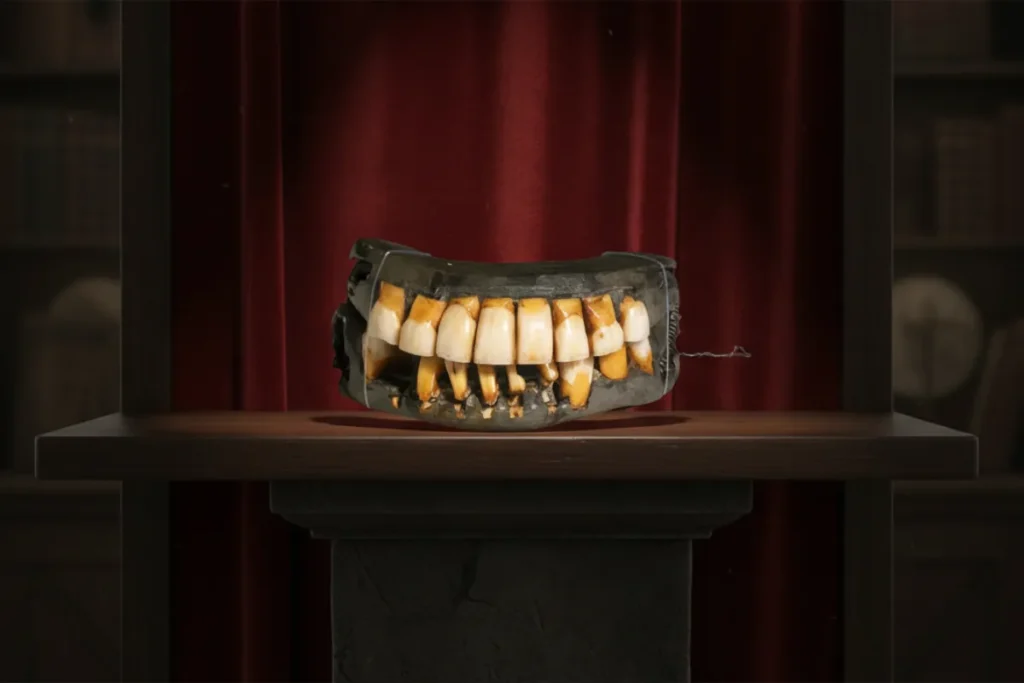
The Consequences of the Washington Wooden Teeth Myth: From Misconception to Folklore
If the physical evidence so clearly refutes the Washington Wooden Teeth Myth, how did the story begin? The most likely origin is a simple, visual misinterpretation. Hippopotamus ivory, the primary material used for the denture plates, is porous. Over the years of use, it would have absorbed stains from Washington’s food and drink, particularly his beloved Madeira wine. This staining, combined with the era’s poor hygiene, would have caused the ivory to crack and darken, developing a grain-like pattern. To a 19th-century observer unfamiliar with the material, the dentures could easily have been mistaken for weathered, dark wood, planting the seed for a historical fiction.
The myth did not appear in print until decades after Washington’s death. It began to circulate in the mid-1800s, an era that romanticized the Founding Fathers and sought to create a national mythology. Anecdotes, whether true or not, were powerful tools for shaping public memory. The story of wooden teeth was memorable, simple, and perfectly aligned with the image of a humble, Cincinnatus-like leader. It was repeated in popular biographies and children’s schoolbooks, and with each retelling, it became more entrenched in the American imagination. The narrative was more appealing than the complex truth, and so the folklore of the Washington Wooden Teeth Myth became history.
The consequences of the Washington Wooden Teeth Myth extend beyond simple historical inaccuracy. By substituting a charming fiction for a difficult reality, the myth sanitizes the past. It erases the brutal, exploitative nature of the 18th-century tooth trade, which often relied on pulling teeth from the mouths of enslaved people and the desperately poor. Furthermore, the myth encourages us to underestimate the technological innovation of the period. Washington’s dentures were not crude carvings but complex, custom-fitted medical devices. Rethinking the Washington Wooden Teeth Myth forces us to confront a more complicated, and therefore more accurate, view of both the man and his era.
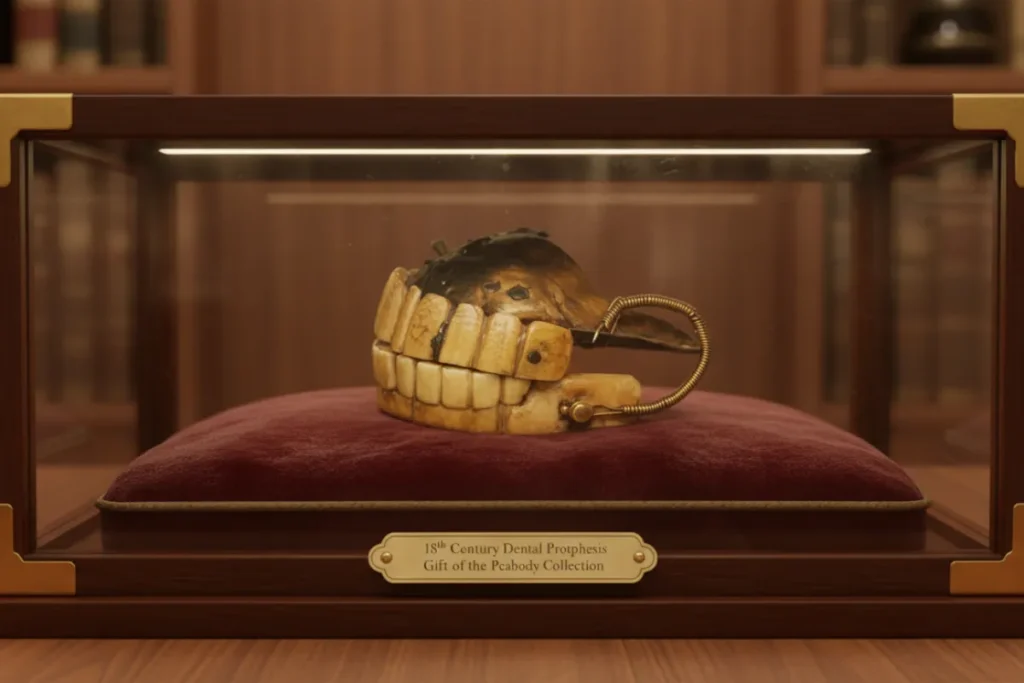
Ivory Dentures History: A Broader Look at 18th-Century Prosthetics
To fully appreciate the inaccuracy of the Washington Wooden Teeth Myth, it is essential to place his dental prosthetics within the broader history of 18th-century technology. Far from being an anomaly, Washington’s dentures were representative of the most advanced—and expensive—solutions available at the time. The era’s premier dental practitioners did not work with wood, a material that would quickly rot and splinter in the mouth. Instead, they were skilled artisans who used durable and costly materials like ivory, gold, and human bone. Washington, as a wealthy member of the elite, had access to the best care money could buy, making his dentures a symbol of status, not rustic simplicity.
Crafting these prosthetics required specialized skill. Men like Dr. John Greenwood, Washington’s most famous dentist, were pioneers in the field. They were part of a transatlantic network of “surgeon-dentists” who developed innovative techniques for taking wax impressions of the gums, carving ivory plates for a precise fit, and engineering complex spring-loaded systems to make the dentures functional for speaking and eating. This was a bespoke, labor-intensive process that merged medical understanding with the fine skills of a jeweler and sculptor. The very existence of this sophisticated craftsmanship directly contradicts the crude imagery associated with the Washington Wooden Teeth Myth.
For the vast majority of the population, however, such advanced dental care was entirely out of reach. The average person in the 18th century had two options for a diseased tooth: endure the pain or have it crudely extracted by a blacksmith or barber-surgeon. Prosthetics were an unimaginable luxury. This context is crucial because it reframes Washington’s experience. His ability to commission multiple sets of high-tech, ivory-and-gold dentures underscores his elite status. The consequences of the Washington Wooden Teeth Myth include flattening this social reality, replacing a story of privilege and technological ambition with a misleading tale of humble resourcefulness.
Why Debunking the Myth Matters: History vs. Hagiography
Correcting the record on the Washington Wooden Teeth Myth is about more than winning a trivia game; it is a fundamental exercise in valuing history over hagiography. Hagiography seeks to create saints out of historical figures, smoothing over their complexities and struggles to present a flawless, inspirational icon. The wooden teeth story fits perfectly into this tradition, offering a simple, moralizing fable. But history’s true value lies not in its ability to provide comfortable myths, but in its power to reveal the messy, difficult, and nuanced truth. Debunking this myth replaces a flimsy piece of folklore with a durable, evidence-based understanding of the past.
The true story of Washington’s teeth reveals a far more compelling and human figure than the myth allows. We see a man who, despite his immense public responsibilities, was in a state of constant, private agony. His willingness to embrace the most advanced, experimental, and even macabre dental technology of his day shows a desperate, relatable desire for relief. This is not the stoic, granite-faced figure from the dollar bill, but a person wrestling with the limitations of his own body. Acknowledging this struggle does not diminish his stature; it deepens our understanding of his resilience and makes his accomplishments all the more remarkable.
Ultimately, this entire examination of the Washington Wooden Teeth Myth underscores the vital importance of material culture in historical inquiry. Written records can be biased, and myths can take on a life of their own, but artifacts do not lie. The surviving dentures at Mount Vernon and other institutions are primary sources that allow us to cut through centuries of folklore and connect directly with the past. By trusting the evidence over the legend, we engage in a more honest form of history—one that challenges us to rethink what we thought we knew and to seek a truth that is always more fascinating than fiction.
Conclusion
We have demonstrated conclusively that the Washington Wooden Teeth Myth is a historical fiction, unsupported by any physical evidence. The narrative of a humble president with simple, wooden dentures has been thoroughly debunked by the surviving artifacts themselves. Analysis of his actual prosthetics reveals a sophisticated and expensive construction of hippopotamus ivory, gold springs, and human teeth. This truth replaces a quaint fable with a powerful story of a leader in chronic pain, a man who pursued the most advanced, and sometimes gruesome, medical technology of his era in a desperate search for relief.
The endurance of this myth serves as a potent example of how easily folklore can supplant history, especially when the fiction is more comforting than the reality. The Washington Wooden Teeth Myth persists because it reinforces a sanitized, romanticized vision of the nation’s founding. It obscures the grim realities of 18th-century life, including the brutal tooth trade and the stark social inequalities that allowed a wealthy man to purchase parts of other people’s bodies. In choosing fable over fact, we lose a vital, nuanced understanding of both George Washington and the complex world he inhabited.
Therefore, the purpose of dismantling the Washington Wooden Teeth Myth extends far beyond mere fact-checking. It is a call to action for a more critical engagement with our own history. We must learn to prioritize primary sources and artifact-based evidence over the seductive pull of national mythology. Let the correction of this single, pervasive falsehood encourage us to question other accepted stories and to seek a more authentic, evidence-based connection to the past. The true, complex history of our nation and its figures will always be more valuable and illuminating than the comforting myths designed to conceal it.
